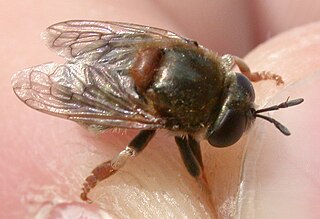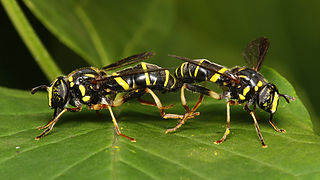| Spazigaster | |
|---|---|
 | |
| Spazigaster ambulans | |
| Scientific classification | |
| Kingdom: | |
| Phylum: | |
| Class: | |
| Order: | |
| Family: | |
| Subfamily: | |
| Tribe: | |
| Genus: | Spazigaster Rondani, 1843 |
Spazigaster is a genus of hoverflies. [1] The genus was first recorded in 1843 in Iran.
| Spazigaster | |
|---|---|
 | |
| Spazigaster ambulans | |
| Scientific classification | |
| Kingdom: | |
| Phylum: | |
| Class: | |
| Order: | |
| Family: | |
| Subfamily: | |
| Tribe: | |
| Genus: | Spazigaster Rondani, 1843 |
Spazigaster is a genus of hoverflies. [1] The genus was first recorded in 1843 in Iran.

The subfamily Microdontinae contains slightly more than 400 species of hoverflies and, while diverse, these species share several characteristics by which they differ from other syrphids. The Microdontinae are myrmecophiles, meaning they live in the nests of ants. Larval Microdontinae are scavengers or predators in ant nests, and, in contrast to other syrphid larvae, have no readily apparent body segmentation. Some species also do not exhibit the typical adult flower-visiting behaviour of other hoverflies, but instead remain near their larval host colonies.

Xylota is a Holarctic genus of hoverflies similar in structure to the related genera Chalcosyrphus and Brachypalpoides. As the larvae are saprophytic they're usually found in rotting wood. The adult flies are generally associated with woodland and woodland edges and can often be seen running over the upper sides of leaves. Unlike other syrphids the adults of many species rarely visit flowers preferring instead to gather pollen from leaf surfaces. There are over 100 described species of which 12 can be found in Europe. Seven species have been recorded in Britain. Identification of species has been difficult and identification by photographs is risky.

Eristalinus is a genus of hoverfly. Most species have very distinctive eye marking in the form of spots or banding, though these features may fade on some preserved specimens. Most are stout flies, and are nimble flyers, even compared to other hoverfly species.

Spilomyia is a genus of hoverflies. Many species in the genus show Batesian mimicry of wasp models, including black and yellow patterns and modified antenna shape.

Eumerus is a genus of hoverflies, within the tribe Eumerini.

Platycheirus is a large genus of hoverflies. They are also called sedgesitters. The genus Platycheirus was established in 1828 by Lepeletier and Serville, with the type specimen of Syrphus scutatus Meigen. This genus is primarily Holarctic in distribution, encompassing 70 species within the Nearctic region. Notably, at least 23 of these Nearctic species are also found in the Palearctic realm, with their approximately 110 species.The distribution of Platycheirus is markedly boreal, with half of the 70 Nearctic species in the Yukon, Northwest Territories, or Alaska. The genus is widespread from Mexico, Central and South America, Europe, Asia, Southeast Asia, Platycheirus are not found in Australia, Indonesia and New Guinea. The genus has a variety of food choices for larvae, ranging from generalized aphid predators to species that specialize in feeding on one or two specific aphid species. Most are feeding within the ground layer of leaf litter.

Melangyna is a genus of hoverflies.

Allograpta is a very large and diverse genus of hoverflies present throughout the world except most of the palearctic region. The adults are brightly coloured flower pollinators and most larvae have a predatory feeding mode involving soft-bodied sternorrhynchans. Certain species have diverged from this and their larvae have been found to be leaf-miners, stem-borers or pollen-feeders.

Toxomerus is a very large genus of hoverflies. They are found in many parts of North and South America. Most larvae are predators on soft bodied insects, though a few species have been shown to feed on pollen. Adults feed on the pollen of a wide range of flowers.

Sphegina is a genus of small, slender hoverflies. They are widespread throughout Eurasia and North America. In flight they seem to have long hind legs which they often carry hanging down, making them resemble sphecid or ichneumonid wasps. Adult Sphegina are usually found in damp and shady habitats close to water in forested areas, and several species can often be found together. They often feed on white and yellow flowers of Apiaceae, Ranunculaceae, Asteraceae, and Rosaceae like Crataegus, Sorbus, and Sorbaria. Larvae nest in the sap of living and dead trees or in decaying cambium under tree bark lying in water or other damp conditions. The larvae of some species have been discovered in the tunnels of other xylophagous insects.

Brachyopa is a Holarctic genus of hoverflies whose grey and brown colouration is unusual for this family and these flies can easily be overlooked amongst members of other fly families. The larvae can be found under the bark of dead branches and trees in decaying sap.

Myolepta is a cosmopolitan genus of hoverflies most closely related to the genus Lepidomyia

Neoascia is a genus of small black and yellow or mostly black flies with a narrow abdomen near the thorax. They occur mainly in damp places among low herbage. The larva of Neosascia are flattened without oral hooks and a have a short posterior spiracular process or "tail", and are saprophagous. In 1925 Curran reviewed the genus Neoascia. In this work a key is provided and ten species are described including four new species some of which have later been determined to be synonyms.
Spheginobaccha is a genus of hoverflies, with 15 known species. The genus is readily separated from other microdons by the incomplete metathoracic bridge, round/oval basoflagellomere, occiput with a dorsolateral crease, and other characters.
Surimyia is a genus of hoverflies, with three known species. They are small microdontine flies. Surimyia is the only hoverfly genus with the katatergum lacking microtrichia. In the subfamily Microdontinae, they are distinctive in the absence of pilosity on the postpronotum.

The Milesiini is a large and diverse tribe of hoverflies. They mimic wasps or hornets.

The Bacchini are a tribe of hoverflies. The tribe Bacchini contains a worldwide distribution of over 430 species. They are mostly small elongate flies with black heads and scutellum. Larvae are predatory mainly upon aphids. Brachini belongs to the subfamily Syrphinae containing 1,600 species. whose larvae feed mostly upon aphids. they in turn belong to the family Surphidae with over 6200 species worldwide..

Pyrophaena is a subgenus of the hoverfly genus Platycheirus distinctive enough to sometimes treated as a separate genus in its own right. Indeed a recent study of the phylogeny of the subfamily Syrphinae found it to be closer to other certain other genera – Rohdendorfia, Syrphocheilosia and Spazigaster. Since only a few species were sampled the true systematic structure must await a more thorough survey of Platycheirus and related genera.
Sterphus is a genus of hoverflies.